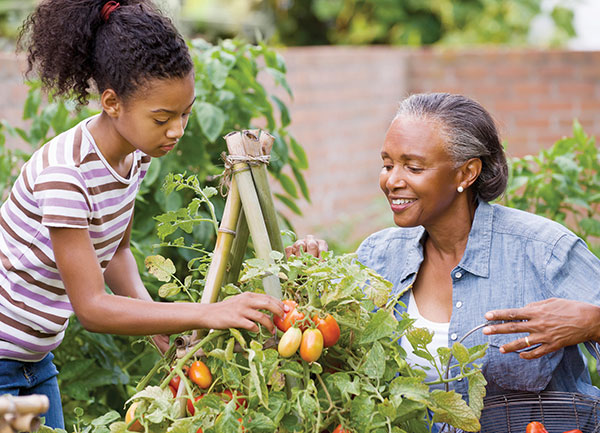New Year, New Sustainable You

Committing to healthier living isn’t just about calories and fitness. Choosing a healthier lifestyle also means making smarter choices for the world around you, especially when it comes to eating and other daily routines.
Commit to doing your part for a healthier environment with these tips:
In and Around the Kitchen
What you eat accounts for a great deal of your environmental impact – in fact, more than one-third of global greenhouse gas emissions caused by human activity can be attributed to the way people produce, process and package food, according to a United Nations-backed study. Factors like animal agriculture, processing, packaging and transportation all influence a food product’s cost to the earth. Being conscious of where and how you shop for food can have a positive effect on the world around you. For example, by shopping local, you can reduce transportation impact. Choosing to buy in-season produce as opposed to fruits and veggies from other regions can also help.
Commit to Reusable Shopping Bags
Each year, Americans use more than 4.2 million tons of plastic bags, sacks and wraps; about 3 million tons of them end up in landfills, according to the Environmental Protection Agency (EPA). Reusable shopping bags are a simple and affordable alternative to bags that end up in the trash. When you do rely on bags from the store, opt for paper, which biodegrades more easily, or if you must choose plastic, save them to reuse at home.
Consider Your Food Footprint
 One simple step you can take is to check the packaging of foods you buy to understand their carbon footprint. For example, each box of Airly Oat Cloud crackers helps remove greenhouse gases from the air through an innovative farming technique that makes agriculture a solution, not a contributor, to climate change. The carbon footprint is on the back of every box, so you can see how many grams of carbon dioxide you are helping remove from the air and start rethinking the food supply chain. Sustainable doesn’t have to mean bland or expensive, however. Made with real, wholesome and 100% truly delicious ingredients, all four flavor varieties (Cheddar, Sea Salt, Chocolate and Salted Caramel) make for delicious, satisfying, convenient anytime snacks.
One simple step you can take is to check the packaging of foods you buy to understand their carbon footprint. For example, each box of Airly Oat Cloud crackers helps remove greenhouse gases from the air through an innovative farming technique that makes agriculture a solution, not a contributor, to climate change. The carbon footprint is on the back of every box, so you can see how many grams of carbon dioxide you are helping remove from the air and start rethinking the food supply chain. Sustainable doesn’t have to mean bland or expensive, however. Made with real, wholesome and 100% truly delicious ingredients, all four flavor varieties (Cheddar, Sea Salt, Chocolate and Salted Caramel) make for delicious, satisfying, convenient anytime snacks.
Plan to Start a Garden
Through the plants’ photosynthesis process, gardens can help manage carbon dioxide while increasing oxygen. Producing your own food means you’re relying less on the supply chain and you have a ready supply of fresh, nourishing food without having to leave your home. Gardens are also natural habitats and food sources to important critters like bees, which play an essential role in pollinating and sustaining the earth’s vegetation.
Eat Less Meat
For many people, creating a more balanced diet means adding more fruits and veggies while cutting back on things like meat and carbs. Diet aside, eating less meat can promote environmental health, too. Agriculture, and livestock production in particular, contributes to global warming. Livestock animals are a significant source of methane gas, which can be more detrimental than carbon dioxide to the atmosphere and is growing at a rapid pace, according to the International Panel on Climate Change. The livestock industry also affects land usage and clean water, among other environmental concerns.
Replace Outdated Appliances
Older kitchen appliances may still get the job done, but chances are that service is coming at a cost to you and the environment. Newer appliances are designed with energy-saving technology, which cuts back on your energy reliance and saves you money on monthly utility bills. When shopping for new appliances, be sure to look for the Energy Star certification so you can be confident you’re buying an environmentally friendly product. Also consider recycling old appliances, when possible, as certain components of them can be reused rather than going to waste.
Practice Upcycling
Giving new life to old things is known as upcycling. It’s a concept that keeps useful things with plenty of functional life from filling landfills. You can practice upcycling by reimagining everything from furniture to clothing. Before tossing an item, consider how it could be used differently or serve a new purpose.
Use Eco-Friendly Cleaning Products
Some cleaning products are full of chemicals that pose hazards to the environment. Green products are generally free of those harsh, smelly chemicals and often come in packaging that is more earth-friendly, too. If you make your own eco-friendly cleaners using household ingredients like baking soda, vinegar and lemon, you can also save some money.
Choose Alternate Modes of Transportation
According to the EPA, transportation is the leading source of greenhouse gas emissions. This is largely due to burning fossil fuels for passenger vehicles, as well as trains, planes and ships. The average passenger vehicle emits 4.6 metric tons of carbon dioxide each year. To make a difference, consider choosing alternate forms of transportation, such as walking, riding a bike or distributing the emissions among more people by choosing public transit or ridesharing.
Explore more ideas for a healthier approach to living at AirlyFoods.com.
Mushroom White Bean Hummus
- 2 cans (15 ounces each) Great Northern or White Navy beans, drained
- 2 cans (6 ounces each) button mushrooms, drained
- 2 tablespoons garlic powder
- 2 tablespoons onion powder
- 1 teaspoon smoked paprika
- 1 teaspoon coriander
- 2 teaspoons sea salt
- 2 teaspoons lemon juice
- 2 teaspoons chopped rosemary
- 1/2 cup olive oil
- 2/3 cup grated Parmigiano Reggiano cheese
- Airly Sea Salt Crackers, for serving
- In food processor, blend beans, mushrooms, garlic powder, onion powder, paprika, coriander, sea salt, lemon juice, rosemary, olive oil and cheese 30 seconds, or until creamy.
- Serve with crackers.
Photos courtesy of Getty Images (Woman in kitchen, Women in garden)


